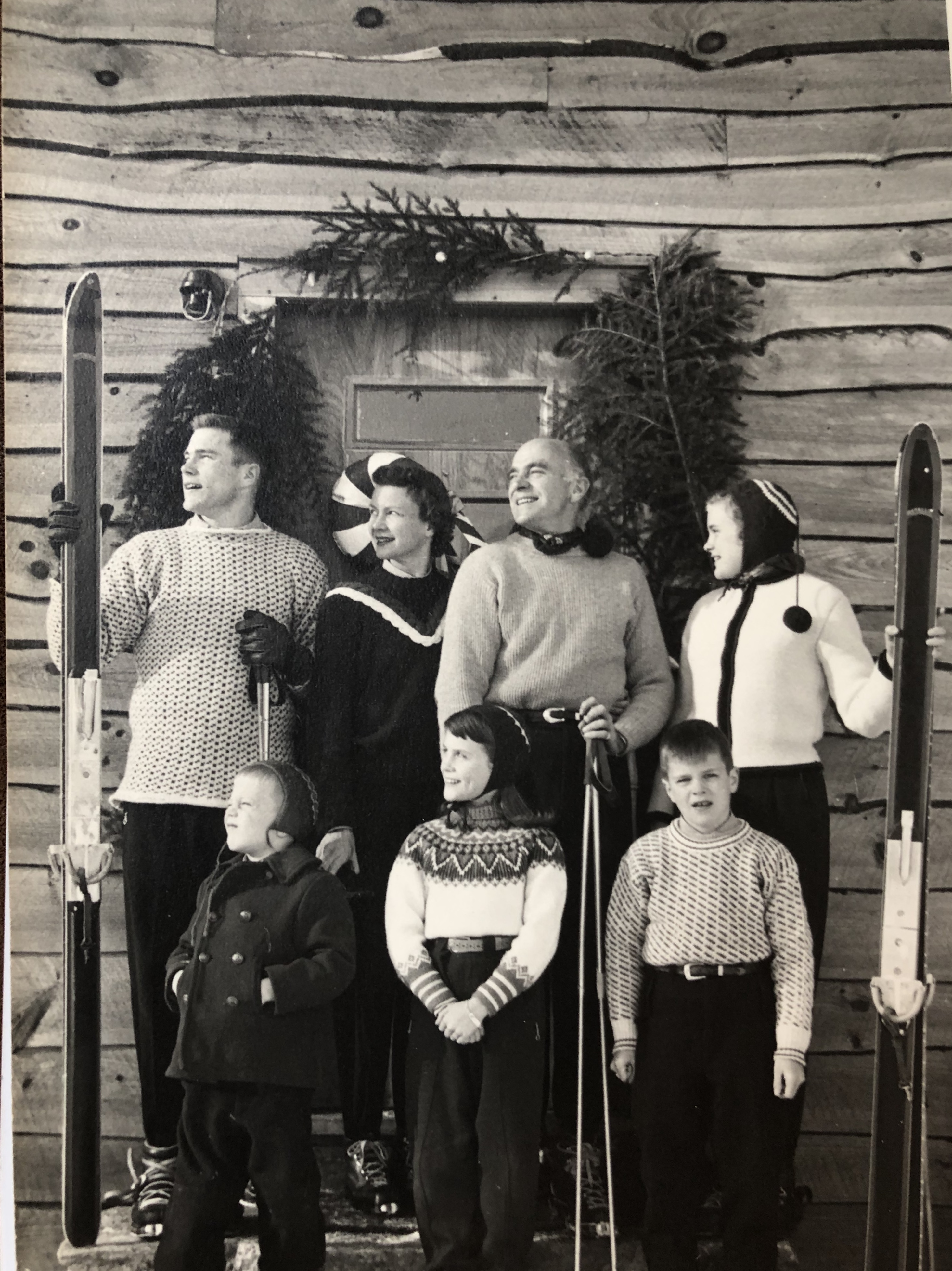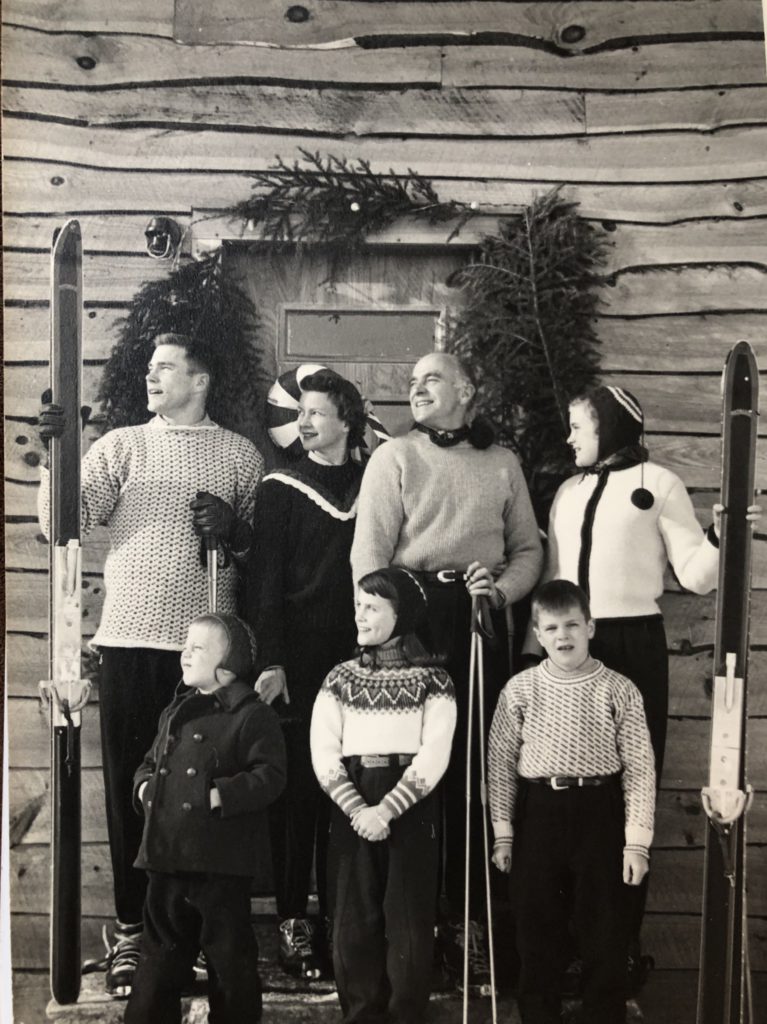[In fond memory of many joyful Christmas vacations in the home my parents built in the mountains, where they were happiest. Merry Christmas to all my Dear Readers at Realskiers.]
It’s no longer regarded as insightful to observe that memories are not only fallible, but often constructed from scratch by the recollector’s imagination. Memory is further distorted when the distant events are culled from fragments originally recorded by a 7-year old mind trying to decipher a world filtered by all but useless eyes.
Among the snapshots that flutter out of the shaken box of memory is one of my immediate siblings and me being dressed in lederhosen, as though our parents had acquired us on a recent trip to Lech. In the same vein, we three were occasionally trotted out to sing some ditty or otherwise perform for the adults, briefly visiting the world of grown-ups and savoring its forbidden allure, accented with cigarette smoke, obsidian ashtrays and silver martini shakers.
The Hogen clan posing in front of the newly constructed cabin at “Deer Crossing” in Peru, Vermont for the 1956 Christmas card. Rear (l. to r.) Tim, mother Carol, father Sonny, Sherrill; Front: John (whom you know as Jackson), Lyn and Robin, who apparently didn’t hear the stage direction to look right. I believe the skis were Alluflex.
As the fifth of five children, all my ski gear was well worn by the time it reached my feet. Niceties like boots that fit or skis with all their edges were reserved for my elders. I believe I was 11 when my godfather, Bill Parrish, who was head of the newly created Ski Industries of America, made my father a deal on a pair of Le Trappeur skis from Quebec. They weren’t exactly Kneissl Blue Stars, but they were new and they were mine.
They died young some two years later when a wedge of spring snow that had insinuated itself under the edge of my right ski’s yellow base tore it half off, shooting me into a grove of birches. I survived, but the skis did not. I knew then that if I wanted better equipment, I would have to earn it.
So it came to pass that I worked the summer of 1965 at a camp down the road in Landgrove, where I earned $15 a week as an untrained and largely unsupervised counselor. (That I was temperamentally unsuited for the job goes without saying.) That September my mother drove me to Hickory & Tweed over in Armonk, NY, where I acquired, with my own money, Rossignol Stratos mounted with Look bindings. I was ready to learn ski racing under the tutelage of Peter Quackenbush McKee, a professor and my housemaster at Andover who immediately recognized my complete lack of talent. Quite a disappointment, considering that brother Robin was regularly anointed as Skimeister after our combined Nordic/Alpine events.
Trying to live up to the promise of my wonderful new skis and my brother’s legacy of excellence, I vaulted, jean-Claude Killy style, out of the start of my first slalom, instantly came out of both heels and wrapped myself ignominiously around the first gate.
McKee’s half-hearted attempts to instruct me in Nordic event skills were seeds that fell on fallow ground. In my first meet at Yale, I was used to slicken the track on the 30-meter hill at St. Michael’s, near Burlington. On my one practice jump, I was still trying to stretch out over my skis when I landed, driving me face first into the crunchy hill, shattering my goggles.
So when I got back to the start where I was due to inaugurate the meet (lousy jumpers went first, like lambs offered up as a sacrifice to Ullr), my goggles were useless. At the time, I wore lenses so thick they could be used in telescopes. When I reprised my opening effort by leaping 25m before landing with my face between my feet, my glasses dug into the tender flesh near my left eye, leaving a red smear in the snow as I slid to an anticlimactic halt.
The second jumper, in all likelihood no more skilled than I, couldn’t have been enthused to hear that the meet was temporarily halted due to blood in the landing area. At the Burlington hospital I was issued a charge card on admission, as if they knew I would be back. Robin won Skimeister for the umpteenth time and I, mercifully, was never asked to jump again.
But like my face that long-ago morning in 1970, I’m getting ahead of myself. Going back to when I was in elementary school, I vividly recall the delight my father and his circle of Peru friends took in “shorties,” the sawed-off skis they made by cutting A-Mori skis in two and mounting the truncated forebodies with cable bindings.
You haven’t heard of A-Mori skis, I bet. Parish imported them from Japan and sold them for a song as a poor man’s Kneissl. They couldn’t have cost much, for brand new ones were sawn in twain in Parish’s workshop, the rear halves discarded like muffin bottoms. Serge Gagarin, one hell of a skier from a family of superb skiers – he even appeared in a John Jay film! – loved to do tricks on them. Parish used his all the time, even to race me, side by side, down the Yodeler at Bromley, me on my Le Trappers, he on his shorties, a wicked grin plastered on his face and a manic glint in his eye.
In that fragile moment I felt as if the grown-up world let down its guard, allowing me to see for the first time that adults had a capacity for unrestrained joy that they somehow suppressed 99% of the time.
Parish won that race, but the financial guarantees required to continue importing brands like Dynastar and Raichle would put his inn, Johnny Seesaw’s, in jeopardy, so he lost out on his bid to make the big time in ski commerce. Meanwhile, Cliff Taylor seized on short skis as the best means of introducing the masses to the sport, earning rightful recognition as an instruction pioneer while Parish’s contribution drifted into anonymity.
I was in no position to appreciate it at the time, but my “Uncle” Bill Parish left deep footprints during skiing’s formative years in this country. Yet I remember him not for his achievements, but for the undiluted ecstasy on his face when he hunched his huge frame into a tuck, his parka flapping in the gathering speed, as he raced me down the hill on his shorties.

